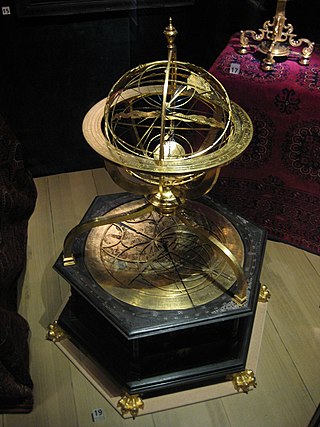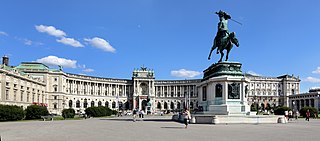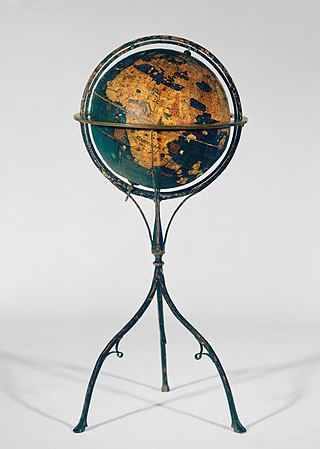
An armillary sphere is a model of objects in the sky, consisting of a spherical framework of rings, centered on Earth or the Sun, that represent lines of celestial longitude and latitude and other astronomically important features, such as the ecliptic. As such, it differs from a celestial globe, which is a smooth sphere whose principal purpose is to map the constellations. It was invented separately, in ancient China possibly as early as the 4th century BC and ancient Greece during the 3rd century BC, with later uses in the Islamic world and Medieval Europe.

A globe is a spherical model of Earth, of some other celestial body, or of the celestial sphere. Globes serve purposes similar to maps, but, unlike maps, they do not distort the surface that they portray except to scale it down. A model globe of Earth is called a terrestrial globe. A model globe of the celestial sphere is called a celestial globe.

Vincenzo Maria Coronelli was an Italian Franciscan friar, cosmographer, cartographer, publisher, and encyclopedist known in particular for his atlases and globes. He spent most of his life in Venice.

The Academy of Fine Arts Vienna is a public art school in Vienna, Austria.

Astronomy in China has a long history stretching from the Shang dynasty, being refined over a period of more than 3,000 years. The ancient Chinese people have identified stars from 1300 BCE, as Chinese star names later categorized in the twenty-eight mansions have been found on oracle bones unearthed at Anyang, dating back to the mid-Shang dynasty. The core of the "mansion" system also took shape around this period, by the time of King Wu Ding.

Jost Bürgi, active primarily at the courts in Kassel and Prague, was a Swiss clockmaker, mathematician, and writer.

The Hofburg is the former principal imperial palace of the Habsburg dynasty in Austria. Located in the centre of Vienna, it was built in the 13th century and expanded several times afterwards. It also served as the imperial winter residence, as Schönbrunn Palace was the summer residence. Since 1946, it has been the official residence and workplace of the president of Austria.

The Austrian National Library is the largest library in Austria, with more than 12 million items in its various collections. The library is located in the Neue Burg Wing of the Hofburg in center of Vienna. Since 2005, some of the collections have been relocated within the Baroque structure of the Palais Mollard-Clary. Founded by the Habsburgs, the library was originally called the Imperial Court Library ; the change to the current name occurred in 1920, following the end of the Habsburg Monarchy and the proclamation of the Austrian Republic. The library complex includes four museums, as well as multiple special collections and archives.

Palais Mollard-Clary is a Baroque palace in Vienna, Austria. It is located in the first district Innere Stadt, at Herrengasse 9.

Museo Galileo is located in Florence, Italy, in Piazza dei Giudici, along the River Arno and close to the Uffizi Gallery. The museum, dedicated to astronomer and scientist Galileo Galilei, is housed in Palazzo Castellani, an 11th-century building which was then known as the Castello d'Altafronte.
Ferdinand Augustin Haller von Hallerstein, also known as August Allerstein or by his Chinese name Liu Songling, was a Jesuit missionary and astronomer from Carniola. He was active in 18th-century China and spent 35 years at the imperial court of the Qianlong Emperor as the head of the Imperial Astronomical Bureau and Board of Mathematics. He created an armillary sphere with rotating rings at the Beijing Observatory and was the first demographer in China who precisely calculated the exact number of Chinese population of the time (198,214,553). He also participated in Chinese cartography, serving concurrently as a missionary, "cultural ambassador" and mandarin between 1739 and 1774.

The Erdapfel is a terrestrial globe 51 cm (20 in) in diameter, produced by Martin Behaim from 1490 to 1492. The Erdapfel is the oldest surviving terrestrial globe. It is constructed of a laminated linen ball in two halves, reinforced with wood and overlaid with a map painted on gores by Georg Glockendon. These intricate details were based on navigational charts by Jorge de Aguiar, incorporating paper maps meticulously pasted onto a parchment layer encircling the globe.
The Honcheonsigye is an astronomical clock made by Song Yi-Yeong, a professor of Gwansanggam in 1669. It was designated as South Korean national treasure number 230 in August 9, 1985.

The Esperanto Museum and Collection of Planned Languages, commonly known as the Esperanto Museum, is a museum for Esperanto and other constructed languages in Vienna, Austria. It was founded in 1927 by Hofrat Hugo Steiner and was incorporated into the Austrian National Library as an independent collection in 1928. Today, it is a museum, library, documentation center, and archive. It accommodates the largest collection of constructed languages in the world and a linguistic research library for language planning. Its catalogue is available online.

The Theatermuseum is a federal museum of national theatre history. Since 1991 it is situated in the Palais Lobkowitz in Vienna.

The grounds of the Palais des Nations contain many fine objects donated by member states of the United Nations, private sponsors and artists. The Celestial Sphere in the Ariana Park of the Palais des Nations is the best-known of these. The huge—over four-meter-diameter—Celestial Sphere is the chef d'oeuvre of the American sculptor Paul Manship (1885–1966). It was donated in 1939 by the Woodrow Wilson Foundation to what was then the League of Nations building. Known also as the Woodrow Wilson Memorial Sphere of the Palais des Nations it is today a symbol of Geneva International and of Geneva as the centre of dialogue and peace.

The Ephesos Museum in Vienna displays antiquities from the city of Ephesus, in modern-day Turkey. Begun in the late 19th century, the collection includes original works of sculpture and architecture, and belongs to the Kunsthistorisches Museum.

A map collection or map library is a storage facility for maps, usually in a library, archive, or museum, or at a map publisher or public-benefit corporation, and the maps and other cartographic items stored within that facility.

The Papyrus Collection of the Austrian National Library, also known as the Rainer Collection and Vienna Papyrus Collection, is a papyrus collection of the Austrian National Library at Hofburg palace in Vienna. It contains around 180,000 objects overall. It is one of the most significant collections in papyrology, containing writings documenting 3 millennia of the history of Egypt from 1500 BCE–1500 CE: Ancient Egypt, Hellenistic Egypt, Roman Egypt, and Egypt during Muslim rule. It includes a specialist library of around 19,500 books and journals as well. The Austrian National Library preserves and restores the stored papyri and facilitates scholarly research and publication based on these ancient documents.
The International Coronelli Society for the Study of Globes is a non-profit academic organization devoted to the analysis, restoration and comprehensive study of terrestrial and celestial globes and other cosmographical instruments, such as armillary spheres and planetaria, mainly made before 1850.


















